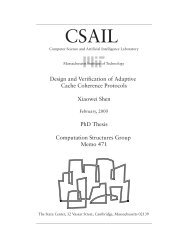DE2-70 Manual - Computation Structures Group
DE2-70 Manual - Computation Structures Group
DE2-70 Manual - Computation Structures Group
Create successful ePaper yourself
Turn your PDF publications into a flip-book with our unique Google optimized e-Paper software.
Figure 3.7. Accessing the SDRAM-U1.<br />
<strong>DE2</strong>-<strong>70</strong> User <strong>Manual</strong><br />
A 16-bit word can be written into the SDRAM by entering the address of the desired location,<br />
specifying the data to be written, and pressing the Write button. Contents of the location can be<br />
read by pressing the Read button. Figure 3.7 depicts the result of writing the hexadecimal value<br />
06CA into location 200, followed by reading the same location.<br />
The Sequential Write function of the Control Panel is used to write the contents of a file into the<br />
SDRAM as follows:<br />
1. Specify the starting address in the Address box.<br />
2. Specify the number of bytes to be written in the Length box. If the entire file is to be<br />
loaded, then a checkmark may be placed in the File Length box instead of giving the<br />
number of bytes.<br />
3. To initiate the writing of data, click on the Write a File to Memory button.<br />
4. When the Control Panel responds with the standard Windows dialog box asking for the<br />
source file, specify the desired file in the usual manner.<br />
The Control Panel also supports loading files with a .hex extension. Files with a .hex extension are<br />
ASCII text files that specify memory values using ASCII characters to represent hexadecimal<br />
values. For example, a file containing the line<br />
0123456789ABCDEF<br />
defines four 8-bit values: 01, 23, 45, 67, 89, AB, CD, EF. These values will be loaded consecutively<br />
17

















